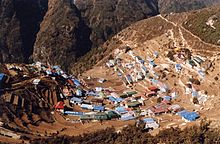Khumbu
Khumbu or Khumbu Himal is a region of the Himalayas in northeastern Nepal on the border with Tibet . In it lies the Sagarmatha National Park with Mount Everest .
Location and landscape
The Khumbu area consists of the river valleys of the three rivers Bhotekoshi , Dudhkoshi and Imja Khola , which are separated from each other by mountain ridges. These valleys rise steadily and turn into large glaciers (e.g. Khumbu glaciers ), which in turn pour from six to eight-thousanders.
The Khumbu foreland is called Solu . The two regions combined form the Solukhumbu district . The Khumbu is not an administrative unit within the Solukhumbu, but a scenic region that is geographically and culturally delimited.
The capital of Solukhumbu is Salleri .
The entire Khumba area is developed through numerous trekking trails, contains a well-developed network of hostels and is one of the most popular trekking regions in the Himalayas ( see also Mount Everest Trek ).
mountains
| Mountains in the Khumbu | |||||||||||||||||||||||||||||||||||||
|
|
||||||||||||||||||||||||||||||||||||
The part of the Himalayas that extends over the Khumbu area is known as the Mahalangur Himal .
Many of the holy mountains (Mount Everest, Cho Oyu, Ama Dablam) have now been climbed. The only exception is the Khumbi Yul Lha , the "Holy Mother of the Khumbu", whose ascent is absolutely taboo.
colonization
The majority of the Khumbu population are made up of Sherpas . This ethnic group from Tibet also lives in the Khumbu foreland of Solu.
In contrast to the rest of Hindu Nepal, this part of the country is almost exclusively Buddhist . The religious center is the monastery of Tengboche (3,860 m). In the monastery of Khumjung (3,780 m) the legendary Yeti scalp is kept in a tin cupboard.
The main town of the Khumbu is Namche Bazar (3,440 m). Namche is at the interface of the Khumbu valleys and thus all trekking routes. Other localities are Chukhung , Dingboche , Khumjung , Khunde , Lobuche , Machermo , Pangboche , Phortse and Thame .
In addition to the places where Sherpas traditionally live from potato cultivation and yak breeding in addition to running hostels, some new places have emerged from former high alpine pastures through trekking tourism, such as Gorak Shep or Gokyo .
traffic
The domestic airport Tenzing Hillary Airport in Lukla is served daily from Kathmandu. From Lukla there are only footpaths (1–2 days to Namche). As an alternative to the flight, Lukla can be reached from Jiri (in the western Dolakha district in Anchal Janakpur) with a one-week trek. There is still an unpaved runway in Syangboche (3,720 m) for goods transport , which is currently only approached by helicopters and not in regular service.
There are no roads in the Khumbu, all goods are transported by porters, yaks or dzopkyos (a cross between yak and domestic cattle).
literature
- Jamie McGuinness: Trekking in the Everest Region. 5th edition. Trailblazer Publications, Surrey 2009, ISBN 978-1-873756-99-7 .
- Stanley F. Stevens: Claiming the High Ground. Sherpas, Subsistence, and Environmental Change in the Highest Himalaya . University of California Press, Berkeley CA 1993, ISBN 0-585-10825-0 .




